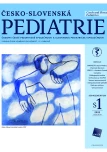Tick-borne tularemia in a four-year-old girl
Authors:
Vávrová Eva 1; Homola Lukáš 1; Mach Vlastirad 2; Lindušková Jana 3; Krbková Lenka 1
Authors‘ workplace:
Klinika dětských infekčních nemocí, FN Brno
1; Klinika dětské radiologie, FN Brno
2; Oddělení klinické mikrobiologie a imunologie, FN Brno
3
Published in:
Čes-slov Pediat 2023; 78 (Supplementum 1): 20-23.
Category:
Case Report
doi:
https://doi.org/10.55095/CSPediatrie2023/028
Overview
Tularaemia is a widespread zoonosis, which should be considered in differential diagnostics of lymphadenopathy despite of relatively low incidence of the disease. In the presented case we would like to point out a tick bite as a possible way of transmission of an ulceroglandular form of tularaemia in children as well as underline PCR method as an early and reliable form of detection.
Keywords:
lymphadenopathy – Francisella tularensis – tularaemia – ulceroglandular form – tick bite
Sources
1. NRC pro analýzu epidemiologických dat. Výskyt vybraných hlášených infekcí v České republice, leden–prosinec 2021: porovnání se stejným obdobím v letech 2012–2020 (počet případů). SZÚ. [online]. 2021. [cit. 14. 2. 2022]. Dostupné z: http://www.szu.cz/uploads/documents/szu/infekce/ 2021/tabulka_leden_prosinec_2021.pdf
2. Č erný Z. Tularemie. In: Beneš J (ed.). Infekční lékařství. 1. vydání. Praha: Galén 2009 : 256–259.
3. Vágnerová I, Mikušková E, Kohnová I, et al. Kazuistika oroglandulární formy tularemie s překvapivým kultivačním záchytem nokardií ve zkolikvované uzlině. Pediatr praxi 2005; 2 : 95–97.
4. Chrdle A, Tinavská P, Dvořáčková O, et al. Early diagnosis of tularemia by flow cytometry, Czech republic, 2003–2015. Emerg Infect Dis 2019; 25(10): 1919–1927.
5. K ukla R, Kračmarová R, Ryšková L, et al. Francisella tularensis caused cervical lymphadenopathy in little children after a tick bite: Two case reports and a short literature review. Ticks Tick Borne Dis 2022; 13(2): 101893.
6. S tátní zdravotní ústav. Tularemie (zaječí nemoc). Národní zdravotnický informační portál. [online]. 2022. [cit. 14. 2. 2022]. Dostupné z: https:// www.nzip.cz/clanek/223-tularemie
7. R oháčová H. Onemocnění přenášená klíšťaty. Interní Med 2006; 6 : 280 – 283.
8. M arkowicz M, SchÖtta AM, Penatzer F, et al. Isolation of Francisella tularensis from skin ulcer after a tick bite, Austria, 2020. Microorganisms 2021; 9(7): 1407.
9. SjÖstedt A, Eriksson U, Berglund L, et al. Detection of Francisella tularensis in ulcers of patients with tularemia by PCR. J Clin Microbiol 1997; 35 : 1045–1048.
10. Karlı A, Şensoy G, Paksu S, et al. Treatment-failure tularemia in children. Korean J Pediatr 2018; 61(2): 49–52.
11. S tátní ústav pro kontrolu léčiv. SPC Ciprofloxacin kabi 100, 200, 400 mg. SÚKL. [online]. 2012. [cit. 25. 8. 2022]. Dostupné z: https://www.sukl.cz/ download/spc/SPC33814.pdf
Labels
Neonatology Paediatrics General practitioner for children and adolescentsArticle was published in
Czech-Slovak Pediatrics

2023 Issue Supplementum 1
Most read in this issue
- Pityriasis rosea Gibert
- Infections caused by respiratory syncytial viruses – epidemiology, clinical picture, diagnosis, prevention and treatment options
- Tularemia – case series
- Tick-borne tularemia in a four-year-old girl
